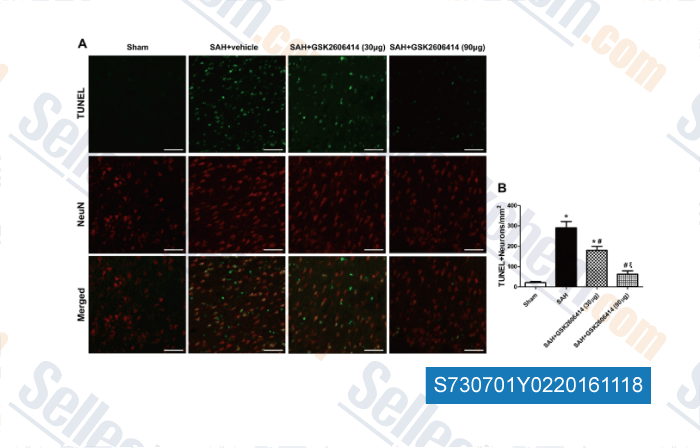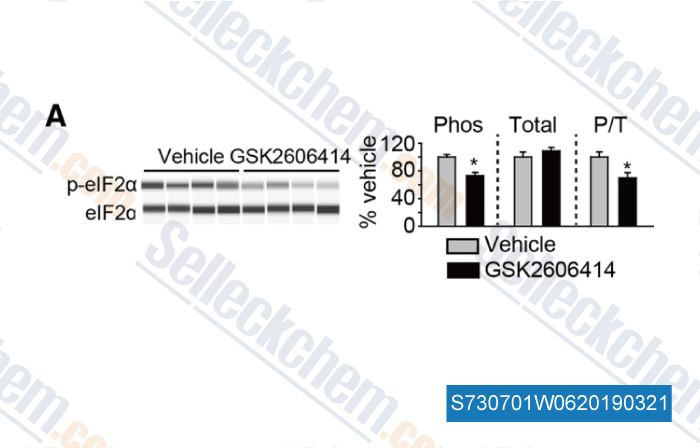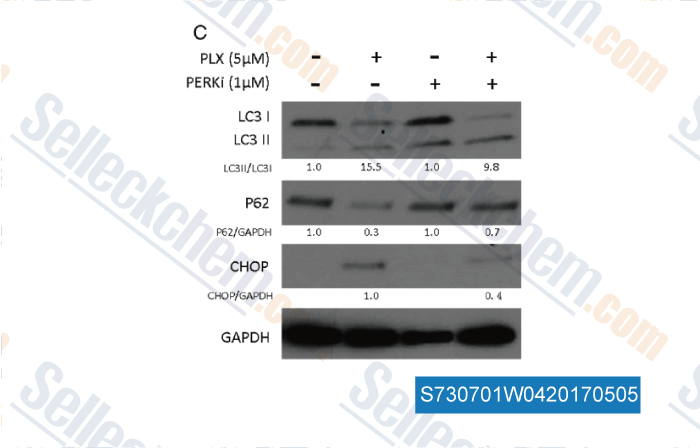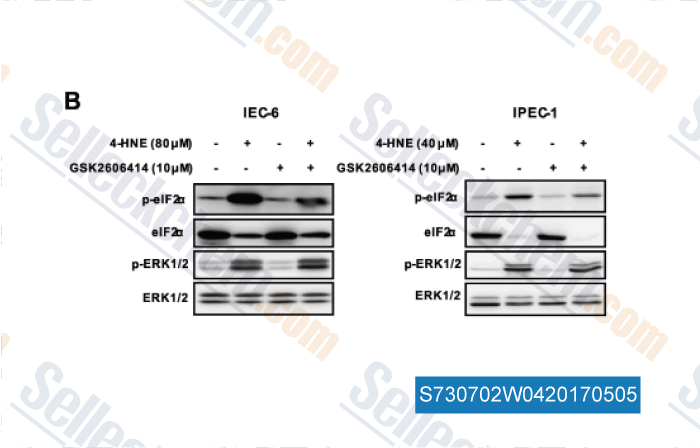|
Toll Free: (877) 796-6397 -- USA and Canada only -- |
Fax: +1-832-582-8590 Orders: +1-832-582-8158 |
Tech Support: +1-832-582-8158 Ext:3 Please provide your Order Number in the email. |
Technical Data
| Formula | C24H20F3N5O |
||||||||||
| Molecular Weight | 451.44 | CAS No. | 1337531-36-8 | ||||||||
| Solubility (25°C)* | In vitro | DMSO | 90 mg/mL (199.36 mM) | ||||||||
| Ethanol | 19 mg/mL (42.08 mM) | ||||||||||
| Water | Insoluble | ||||||||||
| In vivo (Add solvents to the product individually and in order) |
|
||||||||||
|
* <1 mg/ml means slightly soluble or insoluble. * Please note that Selleck tests the solubility of all compounds in-house, and the actual solubility may differ slightly from published values. This is normal and is due to slight batch-to-batch variations. * Room temperature shipping (Stability testing shows this product can be shipped without any cooling measures.) |
|||||||||||
Preparing Stock Solutions
Biological Activity
| Description | GSK2606414 is an orally available, potent, and selective PERK inhibitor with IC50 of 0.4 nM, displaying at least 100-fold selectivity over the other EIF2AKs assayed. This compound impairs GANT-61 induced autophagy in NB cells with MYCN amplification. It exacerbates ER stress-induced apoptosis in HCT116 cells while reduces the apoptosis in SIL1 KD HeLa cells. | ||
|---|---|---|---|
| Targets |
|
||
| In vitro | This compound inhibits PERK Autophosphorylation in A459 Cells with IC50 of <0.3 μM. [1] |
||
| In vivo | GSK2606414 exhibits high oral availability, and low to moderate blood clearance in mouse, rat, and dog. This compound, administered orally, inhibits tumor growth in a dose-dependent manner in mice bearing pancreatic human BxPC3 tumors. [1] |
||
| Features | The first PERK-selective inhibitor with good oral bioavailability and crosses the blood-brain barrier. |
Protocol (from reference)
| Kinase Assay: |
|
|---|---|
| Cell Assay: |
|
| Animal Study: |
|
References
|
Customer Product Validation

-
, , Mol Neurobiol, 2016, 54(3):1808-1817

-
Data from [ , , J Neurosci, 2018, 38(9):2372-2384 ]

-
Data from [ , , J Clin Endocrinol Metab, 2017, 102(2):634-643 ]

-
Data from [ , , Sci Rep, 2016, 6:32929 ]
Selleck's GSK2606414 Has Been Cited by 98 Publications
| Intra-tumoral hypoxia promotes CD8+ T cell dysfunction via chronic activation of integrated stress response transcription factor ATF4 [ Immunity, 2025, 58(10):2489-2504.e8] | PubMed: 41005293 |
| Ivabradine induces RAD51 degradation, potentiating PARP inhibitor efficacy in non-germline BRCA pathogenic variant triple-negative breast cancer [ J Transl Med, 2025, 23(1):860] | PubMed: 40764992 |
| Pharmacological Modulation of the Unfolded Protein Response as a Therapeutic Approach in Cutaneous T-Cell Lymphoma [ Biomolecules, 2025, 15(1)76] | PubMed: 39858470 |
| CRISPR-Based Gene Dependency Screens reveal Mechanism of BRAF Inhibitor Resistance in Anaplastic Thyroid Cancer [ bioRxiv, 2025, 2025.06.26.661609] | PubMed: 40667288 |
| The ribotoxic stress response drives UV-mediated cell death [ Cell, 2024, 187(14):3652-3670.e40] | PubMed: 38843833 |
| Malate initiates a proton-sensing pathway essential for pH regulation of inflammation [ Signal Transduct Target Ther, 2024, 9(1):367] | PubMed: 39737965 |
| MANF facilitates breast cancer cell survival under glucose-starvation conditions via PRKN-mediated mitophagy regulation [ Autophagy, 2024, 1-22.] | PubMed: 39147386 |
| Nucleus pulposus cells regulate macrophages in degenerated intervertebral discs via the integrated stress response-mediated CCL2/7-CCR2 signaling pathway [ Exp Mol Med, 2024, 56(2):408-421.] | PubMed: 38316963 |
| RACK1 promotes autophagy via the PERK signaling pathway to protect against traumatic brain injury in rats [ CNS Neurosci Ther, 2024, 30(3):e14691] | PubMed: 38532543 |
| Integrated stress response (ISR) activation and apoptosis through HRI kinase by PG3 and other p53 pathway-restoring cancer therapeutics [ Oncotarget, 2024, 15:614-633] | PubMed: 39288289 |
RETURN POLICY
Selleck Chemical’s Unconditional Return Policy ensures a smooth online shopping experience for our customers. If you are in any way unsatisfied with your purchase, you may return any item(s) within 7 days of receiving it. In the event of product quality issues, either protocol related or product related problems, you may return any item(s) within 365 days from the original purchase date. Please follow the instructions below when returning products.
SHIPPING AND STORAGE
Selleck products are transported at room temperature. If you receive the product at room temperature, please rest assured, the Selleck Quality Inspection Department has conducted experiments to verify that the normal temperature placement of one month will not affect the biological activity of powder products. After collecting, please store the product according to the requirements described in the datasheet. Most Selleck products are stable under the recommended conditions.
NOT FOR HUMAN, VETERINARY DIAGNOSTIC OR THERAPEUTIC USE.
